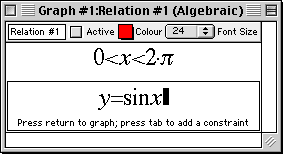


The algebraic relation window consists of the following elements:
The elements of the algebraic relation window are explained as follows:
|
The elements, from left to right, are explained as follows:
|
|

Relation constraints are presented in standard mathematics format. When functions are entered using multiple characters, the characters are presented in red until GrafEq recognizes them as a function name: red signifies unrecognized entries. GrafEq can interpret “sin” as the sine function, instead of the product “s×i×n”, only after an argument, such as x, is entered. A good example is the square root function, when entered as “sqrt”: GrafEq will replace the letters with a graphical radical symbol only after an argument is started.
Standard mathematics format is desirable when including relations in handouts or documents, and can be done by copying relations from GrafEq and pasting them into a word processor. The formatted presentation also gives some visual feedback that constraints are interpreted as intended.
You can move from one constraint to the next by pressing the tab key; if there is no next constraint, a new one will be created. Pressing the tab key while the shift key is held down will move you on to the previous constraint; if there is no previous constraint, a new one will be created.
|
|
|
|

|